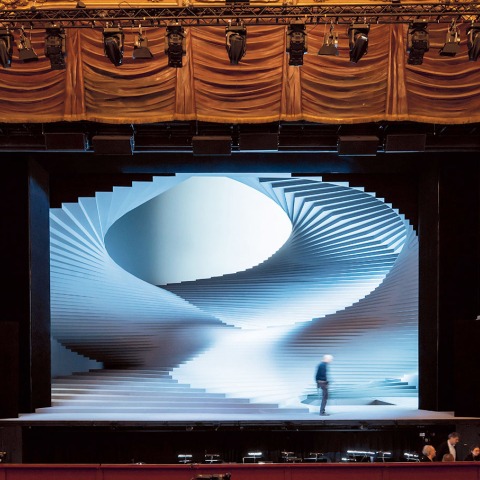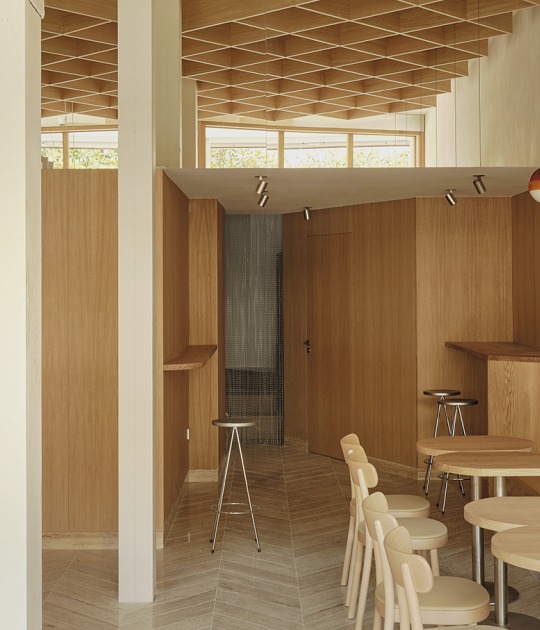The architects, rather than depict a prison in a literal way, designed a kind of modern Piranasian carcere, remembering the three-dimensional space of carceri, a vertical labyrinth.
A abstract set intended, organized as a double-helix which spirals vertically to the full height of the backstage, to reflect and stage the themes Beethoven espoused, namely redemption, freedom, and enlightenment against tyranny. A set to encompass all of the scenes of the two acts which take place in a prison near Seville.
The Oscar-winning actor Christoph Waltz helped realize the stage design. Waltz incorporated references and his design set experience (His father was a set designer, his mother was a costume designer, and his wife, Judith Holste, created the Maoist costumes for the cast).
The final stepped design was consequence of intelligent conversations talking on Czech scenic designer Josef Svoboda works and the Carceri etchings of the 18th-century Italian architect Piranesi.
Also, the impossibility of experiencing the opera live and only being able to broadcast it generated new challenges and reflections. They had the invaluable help of Guardians of the Galaxy cinematographer Henry Braham.
However ingenious film solution, the fact remains that theater is fundamentally a live and uniquely interactive experience. The show may go on, but without the audience, it becomes diminished.
Project description by Barkow Leibinger
Ludwig van Beethoven’s solo opera Fidelio was performed at the Theater an der Wien with a set design by Barkow Leibinger, an intimate and traditional theater, at the site of its original (1806 second version) production in this 250th anniversary year of Beethoven’s birth. Directed by the Oscar-winning actor Christoph Waltz, musical direction was by Manfred Honeck from the Pittsburgh Symphony Orchestra. Due to the Corona outbreak this was an opera that no public had the chance to see in the theater, however, its filming allowed it to reach an ever greater audience.
In close collaboration with Frank Barkow and Christoph Waltz the sets are intended to reflect and stage the themes Beethoven espoused, namely redemption, freedom, and enlightenment against tyranny. The set is intended to be inclusive, that is, to encompass all of the scenes of the two acts which take place in a prison near Seville. Rather than depict a prison in a literal way the set is an abstraction organized as a double-helix which spirals vertically to the full height of the backstage as well as its full depth: a kind of modern Piranasian vertical labyrinth.
This stepping topographical landscape frames a central aperture above which is generally the source for light and movement. The lower levels of the set are defined by overhangs and a “dungeon” gate which allows singers to descend and ascend from below the stage completing a path of movement from high to low and back. The stepped topography of the sets allows singers to march, confront each other, walk, sit, or recline upon its surfaces individually or in large groups (choir). The geometric complexity of the set allows the singers to enter and depart from multiple entrances where movement typically occurs on the diagonal. The opera begins dramatically when the prisoner Florestan is thrown into the prison from above by two guards. Florestan (stuntman) tumbles head over heels 7 meters from the very top entrance to the base of the set marking the onset of his imprisonment and the opera.
This is an architecture complimented by choreographed movement by those artists moving over its surfaces animating and emphasizing its structure and spaces. The set is also an instrument for projecting musical sound.
The set is intentionally spatial and is an extension and complement to the decorative baroque theater itself which utilizes the full depth of the stage and backstage. It is both spatial and sculptural in its three dimensionality which means it changes perspectively depending on the seat in the theater it is viewed from. The golden warmth of the historical theater is contrasted by the cool grays of the set. It encourages and is enforced by dynamic movement: singers can move up and down or back into its recesses singularly or in groups with the sound of their voices projected forward from its cavernous surfaces. The geometry has the further advantage of acoustical projecting balanced sound forward and offers the orchestra conductor visual contact directly to each singer.
The themes and acts of the opera are underscored by the set and lighting. Henry Braham’s lighting concept transforms the sets into multiple ambiances from near darkness to natural appearing daylight from above. The lighting is also calculated to change incrementally and in slight color variations. The verticality of the set allows it to differentiate in relationship to light: bright and glowing above (freedom) or dark and mystical below (the dungeons). Scrims of LED pixels and screen diffusers cover the openings in the set construction and create effects of light, color, reflection, and shadow.
After numerous iterations in digitally (CNC) cut models and digital drawings the final construction was built off-site in Poland in CNC cut timber segments which could fit through the relatively small back-stage doors, then reassembled in the theater like a ship-in-a-bottle. Timber construction allowed for a quick, economical, and sustainable/ re-buildable material. Painted matte gray, in order to facilitate the lighting, the set offers a sculptural backdrop for the singers and the costumes that is minimal, modern, and martial, in a beautiful palette of grays, greens, and olive.
Synopsis: Fidelio
ACT I
Spain, eighteenth century. In a prison, Marzelline, daughter of the jailer, Rocco, rejects the attentions of her father's assistant, Jacquino, who hopes to marry her. Her heart is set instead on the new errand boy, Fidelio. The latter, a hardworking lad, arrives with provisions and dispatches and is distressed by Marzelline's interest in him, especially since it has the blessing of Rocco. Fidelio is in fact Leonore, a noblewoman of Seville who has come to the jail disguised as a boy to find her husband, Florestan, a political prisoner languishing somewhere in chains. When Rocco mentions a man lying near death in the vaults below, Leonore, suspecting it might be Florestan, begs Rocco to take her on his rounds. He agrees, though the governor of the prison, Don Pizarro, allows only Rocco in the lower levels of the dungeon.
As soldiers assemble in the courtyard, Pizarro learns from the dispatches brought to him that Don Fernando, minister of state, is on his way to inspect the fortress. At this news the governor resolves to kill Florestan, his enemy, without delay and orders Rocco to dig a grave for the victim in the dungeon. Leonore, overhearing his plan, realizes Pizarro's evil nature and the plight of his victim. After praying for strength to save her husband and keep up hope, she again begs Rocco to let her accompany him to the condemned man's cell - and also to allow the other prisoners a few moments of air in the courtyard. The gasping men relish their glimpse of freedom but are ordered back by Pizarro, who hurries Rocco off to dig Florestan's grave. With apprehension, Leonore follows him into the dungeon.
ACT II
In one of the lowest cells of the prison, Florestan dreams he sees Leonore arrive to free him. But his vision turns to despair, and he sinks down exhausted. Rocco and Leonore arrive and begin digging the grave. Florestan awakens, not recognizing his wife, and Leonore almost loses her composure at the familiar sound of his voice. Florestan moves the jailer to offer him a drink, and Leonore gives him a bit of bread, urging him not to lose faith. Rocco then blows on his whistle to signal Pizarro that all is ready. The governor advances with dagger drawn to strike, but Leonore stops him with a pistol. At this moment a trumpet sounds from the battlements: Don Fernando has arrived. Rocco leads Pizarro out to meet him as Leonore and Florestan rejoice in each other's arms.
In the prison courtyard, Don Fernando proclaims justice for all. He is amazed when Rocco brings his friend Florestan before him and relates the details of Leonore's heroism. Pizarro is arrested, and Leonore herself removes Florestan's chains. The other prisoners too are freed, and the crowd hails Leonore.









































